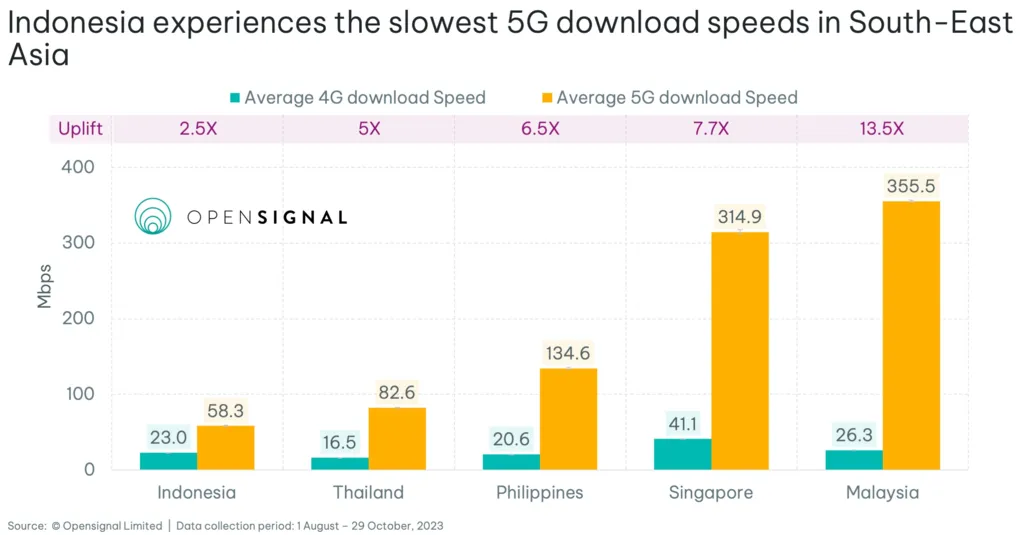Southeast Asia is charging into the future of connectivity. With 5G subscriptions projected to grow from 30 million in 2022 to 620 million by 2028, the region is experiencing one of the fastest infrastructure expansions globally. That's why the massive shift in Southeast Asia 5G infrastructure is more than a tech upgrade, but a digital revolution.
Southeast Asia 5G Infrastructure: Explosive Growth in Connections and Coverage
By 2025, 5G will make up 14% of all mobile connections in Asia-Pacific, rising from 200 million in 2021 to 430 million. In Southeast Asia alone, subscriptions are set to increase at a CAGR of 67%, a pace that reflects both rising demand and aggressive rollout strategies.
Read Also: How Southeast Asia 5G Deployment Is Transforming Tech
Singapore leads with 95% 5G standalone population coverage, while Thailand has crossed 80%, setting benchmarks for others in the region. Countries like Malaysia and Vietnam are investing heavily, and even emerging markets like Indonesia are accelerating deployments.
In rural areas, Fixed Wireless Access (FWA) 5G is a game changer—up to 80% more cost-effective than traditional fiber, making high-speed connectivity affordable and feasible for smaller towns.
Driving Economic Growth and Industry Transformation
The impact of this infrastructure goes beyond faster downloads. Southeast Asia’s digital economy is projected to grow from $194 billion in 2023 to $330 billion by 2025, powered in part by 5G connectivity.
By 2030, mobile providers in the region could unlock $40 billion in new revenue through 5G-enabled services, particularly in smart cities, manufacturing, logistics, and agriculture. These enterprise applications are not just futuristic—they’re already in motion.
Read Also: Southeast Asia Digital Transformation Accelerates Fast in the Region
Singapore’s government, for example, supports enterprise 5G through regulatory sandboxes and grants, enabling new use cases from autonomous vehicles to remote diagnostics in healthcare.
Public-Private Partnerships Accelerating Deployment
A critical driver of Southeast Asia’s 5G progress is the collaboration between governments and telecom giants. Malaysia’s Digital Nasional Berhad (DNB), a state-owned 5G wholesale provider, has achieved 80% population coverage—one of the fastest rollouts globally.
Meanwhile, Thailand’s AIS and Vietnam’s Viettel are partnering with tech firms like Ericsson and Huawei to deploy standalone 5G networks, which offer ultra-low latency for industrial automation.
Read Also: Public-Private Partnerships in Southeast Asia Unlocking Growth
Data Demand and Consumer Experience
Mobile traffic per smartphone in Southeast Asia is expected to reach 54 GB per month by 2028. This supports the region’s booming appetite for video streaming, gaming, online education, and remote work.
As infrastructure improves, so does user experience—but challenges remain. While 96% of the region has mobile broadband coverage, only 44% actively use mobile internet, showing that infrastructure alone isn’t enough.

Bridging this usage gap requires inclusive digital policies, better affordability, and awareness efforts to ensure the benefits of 5G reach underserved populations.
The Road Ahead Southeast Asia 5G Infrastructure
As the region prepares for 560 million 5G subscriptions by 2029, the story isn’t just about speed—it’s about opportunity, innovation, and equity. The question now is: who will use this infrastructure to lead the next digital wave?
The rapid Southeast Asia 5G infrastructure rollout is clearly transforming connectivity and digital access. But growth must also be inclusive and strategic. Countries that invest not only in towers and spectrum, but also in education, access, and enterprise ecosystems, will unlock the full power of 5G. With the right policies and partnerships, Southeast Asia is ready to not just join—but define—the 5G era.







